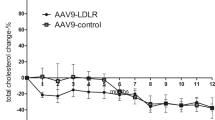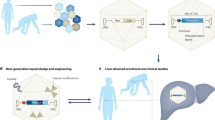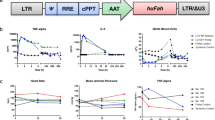Abstract
In this study we report an improved method for in vivo gene transfer to liver. Repeated injections of Moloney murine leukemia virus-derived retroviruses containing LDL receptor cDNA were given to the portal vein in combination with a 10% partial liver resection and stimulation of hepatocyte proliferation by plasmid/liposome-mediated thymidine kinase gene transfer and ganciclovir treatment. The method was used for the treatment of LDL receptor deficiency in Watanabe heritable hyperlipidemic rabbits. We demonstrate an increase in hepatocyte proliferation index by thymidine kinase and ganciclovir treatment from 0.9 to 1.35% and a maximum of 35% decrease in total plasma cholesterol level 2–3 months after the gene transfer. A 20% decline was still present after a 52-week follow-up period. A 50% decrease was also observed in plasma triglycerides. Liver function tests indicated a transient increase in plasma alkaline phosphatase level up to 12 weeks after the gene transfer. In situ PCR and RT-PCR analyses indicated that the transgene was present in periportal areas and was transcribed to mRNA 1 week after the gene transfer. Because of the relatively simple and controllable technique we suggest that repeated retrovirus injections via a portal vein catheter together with the limited partial liver resection and plasmid/liposome-mediated thymidine kinase gene transfer–ganciclovir treatment may be used to improve the results of retrovirus-mediated liver gene therapy.
This is a preview of subscription content, access via your institution
Access options
Subscribe to this journal
Receive 12 print issues and online access
$259.00 per year
only $21.58 per issue
Buy this article
- Purchase on Springer Link
- Instant access to full article PDF
Prices may be subject to local taxes which are calculated during checkout






Similar content being viewed by others
References
Goldstein JL, Brown MS . Familial hypercholesterolemia In: Scriver CR, Beaudet AL, Sly WS, Valle D (eds) . Metabolic Basis of Inherited Disease McGraw Hill: New York 1989 pp 1215–1250
Grundy SM . Treatment of hypercholesterolemia by interference with bile acid metabolism Arch Intern Med 1972 130: 638–648
Grundy SM, Bilheimer DW . Inhibition of 3-hydroxy-3-methylglutaryl-CoA reductase by mevinolin in familial hypercholesterolemia heterozygotes: effects on cholesterol balance Proc Natl Acad Sci USA 1984 81: 2538–2542
Koivisto P, Miettinen TA . Long-term effects of ileal bypass on lipoproteins in patients with familial hypercholesterolemia Circulation 1984 70: 290–296
Schouten JA, Beynen AC . Partial ileal bypass surgery in the treatment of heterozygous familial hypercholesterolemia: a review Artery 1986 13: 240–263
Starzl TE et al. Portacaval shunt in patients with familial hypercholesterolemia Ann Surg 1983 198: 273–283
Bilheimer DW et al. Liver transplantation to provide low-density-lipoprotein receptors and lower plasma cholesterol in a child with homozygous familial hypercholesterolemia New Engl J Med 1984 311: 1658–1664
Zwiener RJ, Uauy R, Petruska ML, Huet BA . Low-density lipoprotein apheresis as long-term treatment for children with homozygous familial hypercholesterolemia J Pediatr 1995 126: 728–735
Thompson GR, Lowenthal R, Myant NB . Plasma exchange in the management of homozygous familial hypercholesterolaemia Lancet 1975 1: 1208–1211
Hoeg JM, Starzl TE, Brewer HB Jr . Liver transplantation for treatment of cardiovascular disease: comparison with medication and plasma exchange in homozygous familial hypercholesterolemia Am J Cardiol 1987 59: 705–707
Yamamoto T et al. Deletion in cysteine-rich region of LDL receptor impedes transport to cell surface in WHHL rabbit Science 1986 232: 1230–1237
Grossman M et al. Successful ex vivo gene therapy directed to liver in a patient with familial hypercholesterolaemia Nat Genet 1994 6: 335–341
Branchereau S, Calise D, Ferry N . Factors influencing retrovirus-mediated gene transfer into hepatocytes in vivo Hum Gene Ther 1994 5: 803–808
Fuller BJ . Transplantation of isolated hepatocytes. A review of current ideas J Hepatol 1988 7: 368–376
Kitten O, Cosset FL, Ferry N . Highly efficient retrovirus-mediated gene transfer into rat hepatocytes in vivo Hum Gene Ther 1997 8: 1491–1494
Bosch A et al. Proliferation induced by keratinocyte growth factor enhances in vivo retroviral-mediated gene transfer to mouse hepatocytes J Clin Invest 1996 98: 2683–2687
Ferry N et al. Retrovirus-mediated gene transfer into hepatocytes in vivo Proc Natl Acad Sci USA 1991 88: 8377–8381
de Roos WK et al. Isolated-organ perfusion for local gene delivery: efficient adenovirus-mediated gene transfer into the liver Gene Therapy 1997 4: 55–62
Forbes SJ et al. Retroviral gene transfer to the liver in vivo during tri-iodothyronine induced hyperplasia Gene Therapy 1998 5: 552–555
Lieber A et al. Adenovirus-mediated urokinase gene transfer induces liver regeneration and allows for efficient retrovirus transduction of hepatocytes in vivo Proc Natl Acad Sci USA 1995 92: 6210–6214
Webber EM et al. Transforming growth factor-alpha expression during liver regeneration after partial hepatectomy and toxic injury, and potential interactions between transforming growth factor-alpha and hepatocyte growth factor Hepatology 1993 18: 1422–1431
Burr AW et al. Intrahepatic distribution of transforming growth factor-alpha (TGF alpha) during liver regeneration following carbon tetrachloride-induced necrosis J Pathol 1993 170: 95–100
Marcel T, Grausz JD . The TMC Worldwide Gene Therapy Enrollment Report, end 1996 Hum Gene Ther 1997 8: 775–800
Culver KW et al. In vivo gene transfer with retroviral vector-producer cells for treatment of experimental brain tumors Science 1992 256: 1550–1552
Ylä-Herttuala S et al. Transfer of 15-lipoxygenase gene into rabbit iliac arteries results in the appearance of oxidation-specific lipid-protein adducts characteristic of oxidized low density lipoprotein J Clin Invest 1995 95: 2692–2698
Chowdhury JR et al. Long-term improvement of hypercholesterolemia after ex vivo gene therapy in LDLR-deficient rabbits Science 1991 254: 1802–1805
Wilson JM et al. Hepatocyte-directed gene transfer in vivo leads to transient improvement of hypercholesterolemia in low density lipoprotein receptor-deficient rabbits J Biol Chem 1992 267: 963–967
Kozarsky KF et al. In vivo correction of low density lipoprotein receptor deficiency in the Watanabe heritable hyperlipidemic rabbit with recombinant adenoviruses J Biol Chem 1994 269: 13695–13702
Grossman M et al. A pilot study of ex vivo gene therapy for homozygous familial hypercholesterolaemia Nature Med 1995 1: 1148–1154
Wada Y, Tsukada M, Kamiyama S, Koizumi A . Evidence of clonal proliferation of hepatocytes after carbon-tetrachloride-induced hepatic injury in PGK-1 mosaic mice Toxicol Lett 1990 52: 81–90
Kawakami S et al. Expression of hepatocyte growth factor in normal and carbon tetrachloride-treated monkeys Hepatology 1994 20: 1255–1260
Brand K et al. Liver-associated toxicity of the HSV-tk/GCV approach and adenoviral vectors Cancer Gene Ther 1997 4: 9–16
van der Eb MM et al. Severe hepatic dysfunction after adenovirus-mediated transfer of the herpes simplex virus thymidine kinase gene and gancilovir administration Gene Therapy 1998 5: 451–458
Yee JK et al. A general method for the generation of high-titer, pantropic retroviral vectors: highly efficient infection of primary hepatocytes Proc Natl Acad Sci USA 1994 91: 9564–9568
Naldini L et al. In vivo gene delivery and stable transduction of nondividing cells by a lentiviral vector Science 1996 272: 263–267
Hermonat PL, Muzyczka N . Use of adeno-associated virus as a mammalian DNA cloning vector: transduction of neomycin resistance into mammalian tissue culture cells Proc Natl Acad Sci USA 1984 81: 6466–6470
Moolten FL . Tumor chemosensitivity conferred by inserted herpes thymidine kinase genes: paradigm for a prospective cancer control strategy Cancer Res 1986 46: 5276–5281
Yamamoto T et al. The human LDL receptor: a cysteine-rich protein with multiple Alu sequences in its mRNA Cell 1984 39: 27–38
Kalnins A, Otto K, Rüther U, Müller-Hill B . Sequence of the lacZ gene of Escherichia coli EMBO J 1983 2: 593–597
Ylä-Herttuala S et al. Colocalization of 15-lipoxygenase mRNA and protein with epitopes of oxidized low density lipoprotein in macrophage-rich areas of atherosclerotic lesions Proc Natl Acad Sci USA 1990 87: 6959–6963
Hiltunen TP, Luoma JS, Nikkari T, Ylä-Herttuala S . Expression of LDL receptor, VLDL receptor, LDL receptor-related protein, and scavenger receptor in rabbit atherosclerotic lesions: marked induction of scavenger receptor and VLDL receptor expression during lesion development Circulation 1998 97: 1079–1086
Laitinen M et al. Gene transfer into the carotid artery using an adventitial collar: comparison of the effectiveness of the plasmid-liposome complexes, retroviruses, pseudotyped retroviruses, and adenoviruses Hum Gene Ther 1997 8: 1645–1650
Hiltunen T, Luoma J, Nikkari T, Ylä-Herttuala S . Induction of 15-lipoxygenase mRNA and protein in early atherosclerotic lesions Circulation 1995 92: 3297–3303
Hiltunen T, Raja-Honkala M, Nikkari T, Ylä-Herttuala S . A PCR artifact under low-stringency conditions due to amplification by only one primer Biotechniques 1994 17: 240–242
Young ID, Ailles L, Deugau K, Kisilevsky R . Transcription of cRNA for in situ hybridization from polymerase chain reaction-amplified DNA Lab Invest 1991 64: 709–712
Luoma J, Ylä-Herttuala S . Atherosclerosis in Watanabe heritable hyperlipidemic rabbit arteries Scand J Lab Anim Sci 1996 23: 195–197
Author information
Authors and Affiliations
Rights and permissions
About this article
Cite this article
Pakkanen, T., Laitinen, M., Hippeläinen, M. et al. Enhanced plasma cholesterol lowering effect of retrovirus-mediated LDL receptor gene transfer to WHHL rabbit liver after improved surgical technique and stimulation of hepatocyte proliferation by combined partial liver resection and thymidine kinase– ganciclovir treatment. Gene Ther 6, 34–41 (1999). https://doi.org/10.1038/sj.gt.3300796
Received:
Accepted:
Published:
Issue Date:
DOI: https://doi.org/10.1038/sj.gt.3300796
Keywords
This article is cited by
-
Bile-duct proliferation as an unexpected side-effect after AAV2-LDLR gene transfer to rabbit liver
Scientific Reports (2019)
-
Current Status of Cardiovascular Gene Therapy
Molecular Therapy (2007)
-
Clinical applications of vascular gene therapy
Current Cardiology Reports (2001)
-
Gene therapy for atherosclerosis and atherosclerosis-related diseases
Current Atherosclerosis Reports (1999)



